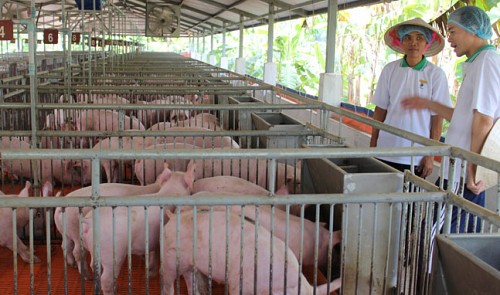Vietnam spends billions to raise livestock on foreign feed

Trung, who raises pigs in southern Dong Nai Province, elaborated that he had to import 100 percent of the necessary amino acid, and 50 percent of the corn and fish powder.
On a larger scope, the national feed manufacturing sector also has to import 70 percent of its necessary ingredients.
Last year Vietnam imported US$3 billion worth of animal feed, a sum that is $50 million higher than its total rice export turnovers, according to the Ministry of Agriculture and Rural Development. The figure is as massive as $4 billion if imports of feed ingredients such as corn, soybeans, and wheat are counted.
The country imported 1.39 million tons of soybeans for $834 million, while the volumes and values of the corn and wheat imports are 2.26 tons and $690 million, and 1.71 million tons and $584 million, respectively.
In the first month of this year alone, Vietnam spent $150 million to import 582,000 tons of corn, an increase of 500 percent in volume and 368 percent in value, also according to the ministry figures.
All corn imports are used in making feed, while 80 percent of the soybean waste and 20 percent of the imported wheat are used for the same purpose, said Pham Duc Binh, deputy chairman of the Vietnam Husbandry Association.
“Vietnam can only afford supplies for bran and cassava, and have to import the remaining ingredients,” he concluded.
While billions of US dollars have been spent on feed imports over the last few years, there does not seem to be any policies to resolve the issue.
What the country lacks is agricultural areas to grow corn, soybeans, and wheat only to serve the feed making industry, said Le Ba Lich, chairman of the Vietnam Husbandry Association.
Vietnam has the potential to increase the supply of such ingredients, but authorities and relevant agencies still refuse to take any action, he said.
Lich said one feasible solution is to grow corn and soybeans on the paddy fields that have poor rice yields to increase supply for the feed making industry.
What the stars mean:
★ Poor ★ ★ Promising ★★★ Good ★★★★ Very good ★★★★★ Exceptional
Latest News
More News
- Growth beckons for GenAI startups in Vietnam (November 21, 2024 | 17:47)
- SABECO to elevate Vietnam's beverage industry to global standards (November 21, 2024 | 17:36)
- ABeam Consulting Vietnam introduces BSQCD Purchasing Strategy Framework (November 21, 2024 | 16:40)
- Major railway requires debt considerations (November 21, 2024 | 12:07)
- Reviving a new life cycle for plastic waste (November 21, 2024 | 09:16)
- Key balances maintained for industrial production (November 21, 2024 | 08:00)
- Ecolean Vietnam honoured with prestigious sustainability award (November 19, 2024 | 10:01)
- HEINEKEN Vietnam’s clear path towards net-zero (November 18, 2024 | 15:13)
- VLCA 2024 honours corporate governance excellence as listed companies raise the bar (November 18, 2024 | 09:00)
- High-tech personnel to drive competition (November 17, 2024 | 09:21)
















 Mobile Version
Mobile Version